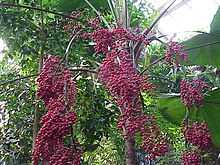Licuala
Not to be confused with Likouala.
| Licuala | |
|---|---|
 | |
| Licuala grandis | |
| Scientific classification | |
| Kingdom: | Plantae |
| (unranked): | Angiosperms |
| (unranked): | Monocots |
| (unranked): | Commelinids |
| Order: | Arecales |
| Family: | Arecaceae |
| Subfamily: | Coryphoideae |
| Tribe: | Corypheae |
| Genus: | Licuala Wurmb, 1780 |
| Synonyms[1] | |
| |

Licuala ramsayi.
Licuala is a genus of palms commonly found in tropical rainforests of southern China, Southeast Asia, the Himalayas, New Guinea and the western Pacific Ocean islands.[1][2][3][4][5] They are fan palms, with the leaves mostly circular in outline, sometimes undivided but more usually divided into wedge-shaped segments. Licuala acutifida is the source of cane for the walking stick nicknamed the Penang-lawyer by colonials, probably from the Malay phrase pinang liyar for a wild areca, although the term may also refer to the use of these canes as deadly knobkerries to assassinate litigious enemies.[6]
- Selected species
Approximately 150 species are recognized.[1]
- Licuala acutifida
- Licuala dasyantha
- Licuala ferruginea
- Licuala grandis
- Licuala lauterbachii
- Licuala orbicularis
- Licuala paludosa
- Licuala pitta Vatch. ex Barfod & Pongsattayapipat
- Licuala peltata
- Licuala poonsakii Hodel
- Licuala pumila
- Licuala ramsayi
- Licuala rumphii
- Licuala spinosa
- Licuala taynguyensis Barfod & Borchs.
New Guinean Species
- Licuala beccariana
- Licuala bifida Heatubun & Barfod
- Licuala crassiflora Barfod
- Licuala graminifolia Heatubun & Barfod
- Licuala longispadix Banka & Barfod
References
- ↑ 1.0 1.1 1.2 Kew World Checklist of Selected Plant Families
- ↑ Govaerts, R. & Dransfield, J. (2005). World Checklist of Palms: 1-223. The Board of Trustees of the Royal Botanic Gardens, Kew.
- ↑ Flora of China, Vol. 23 Page 148, 轴榈属 zhou lü shu, Licuala Wurmb, Verh. Batav. Genootsch. Kunst. 2: 473. 1780
- ↑ Saw, L.G. (2012). A revision of Licuala (Arecaceae, Coryphoideae) in Borneo. Kew Bulletin 67: 577-654.
- ↑ Heatubun, C.D., Barfod, A.S. 2008, Two new species of 'Licuala' (Arecaceae; Coryphoideae) from Western new Guinea. Blumea. 53(2): 429–434.
- ↑ Germplasm Resources Information Network: Licuala